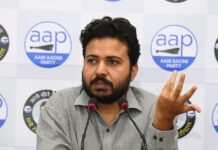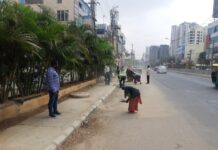
New Delhi, All stakeholders and the governments need to work together to free Delhi from water and air pollution, Union Minister for Water Resources Nitin Gadkari said on Thursday as he laid the foundation stone for nine projects for the Yamuna rejuvenation under the Namami Gange Programme here.
Delhi Chief Minister Arvind Kejriwal and Union Minister for Environment, Forest & Climate Change Dr Harsh Vardhan were also present to lay the foundation stones.
A total of 11 projects have been taken up by the National Mission for Clean Ganga (NMCG) to conserve the 22-km stretch of the Yamuna in the national capital.
“Most of the projects are for the sewerage infrastructure and are at various stages of implementation. These projects under Yamuna Action Plan (YAP) III are located in three drainage zones — Kondli, Rithala and Okhla in Delhi,” Gadkari said.
“The mandate for cleaning the tributaries of the Ganga was taken up with the launch of Namami Gange programme. With these projects, the sewage water falling into river Yamuna will be stopped,” he added.
Mentioning the Lakhwar multi-purpose project in the upper Yamuna basin, Gadkari said that once that project is complete, the Yamuna will flow without any interruption in Delhi. “For the same, trash skimmer is already deployed for Yamuna in Delhi for river surface cleaning,” he said.
Gadkari in his speech added that apart from Delhi, interventions for Yamuna cleaning are also being made in Haryana (Panipat and Sonepat) and Uttar Pradesh (Mathura-Vrindavan). “A sewage treatment plant project of 180 million litres per day (MLD) has also been approved in Agra,” he said.
While extending all possible support for the development of Delhi, he urged all stakeholders to join hands and work on a war-footing to make Delhi free of water and air pollution.
“The Ganga will be 70 to 80 per cent clean by March 2019, and it will be almost completely free of pollution by March 2020,” the Minister said as he reiterated the government’s Namami Gange Programme.
Dr Harsh Vardhan, on the other hand, said the 1,365-km long Yamuna, covering 22 km in Delhi (from Okhla barrage to Wazirabad) is responsible for 80 per cent of the pollution in the river. He also urged that a people’s movement is required to rejuvenate Ganga.
“Our ministry has collaborated with Clean Ganga Mission on issues like high-resolution survey of Ganga and real water quality monitoring to clean the river,” he said.
In his speech, Kejriwal said such programmes are very important for the federal structure of the country and that all governments should be on the same page for development issues.
Minister of State for Water Resources, River Development and Ganga Rejuvenation Dr Satya Pal Singh, Delhi Deputy Chief Minister Manish Sisodia, Secretary, Ministry of Water Resources, River Development and Ganga Rejuvenation U.P. Singh and Director General, NMCG Rajiv Ranjan Mishra were also present on the occasion.
The current sewage generation for the national capital is about 327 crore liters per day against the existing treatment capacity of 276 crore liters per day.
Phase 1 of the Yamuna Action Plan (YAP) was taken up for Delhi during 1993-2003 and YAP-II was extended in 2003 to cover Uttar Pradesh and Haryana along with Delhi.
Building on the previous phases, the government then launched YAP-III in collaboration with Japan International Cooperation Agency (JICA) in Delhi at an estimated cost of Rs 1,656 crore.
Under YAP-III, a total of eight projects are focused on sewerage infrastructure. It includes the creation of a sewage treatment plant (STP) with a capacity of treating 56.4 crore liters of sewage per day at Okhla, rehabilitation and upgradation of an STP with 38.6 crore liters per day capacity, and rehabilitation of trunk sewer and rising main of 35-km length in Kondli and Rithala zones.
“The sewerage projects are being taken up in four packages of Kondli (K1, K2, K3, K4), three packages of Rithala (R1a, R1b, R2) and Okhla zone (O). Out of these, seven projects are at various stages of implementation and one project of Okhla zone is under tendering process,” Gadkari said.
In addition to the eight projects, the foundation was also laid for nine decentralized STPs (with a capacity of total 2.25 Crore litres per day) and water bodies rejuvenation at Chattarpur at a cost of Rs 65.24 crore.








